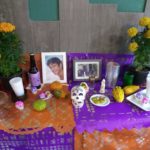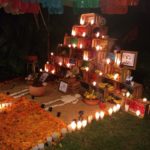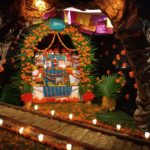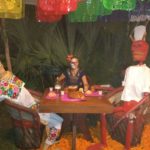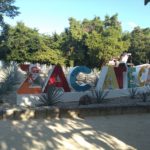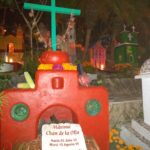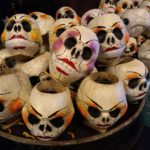Dia de Muertos – Day of the Dead in Mexico
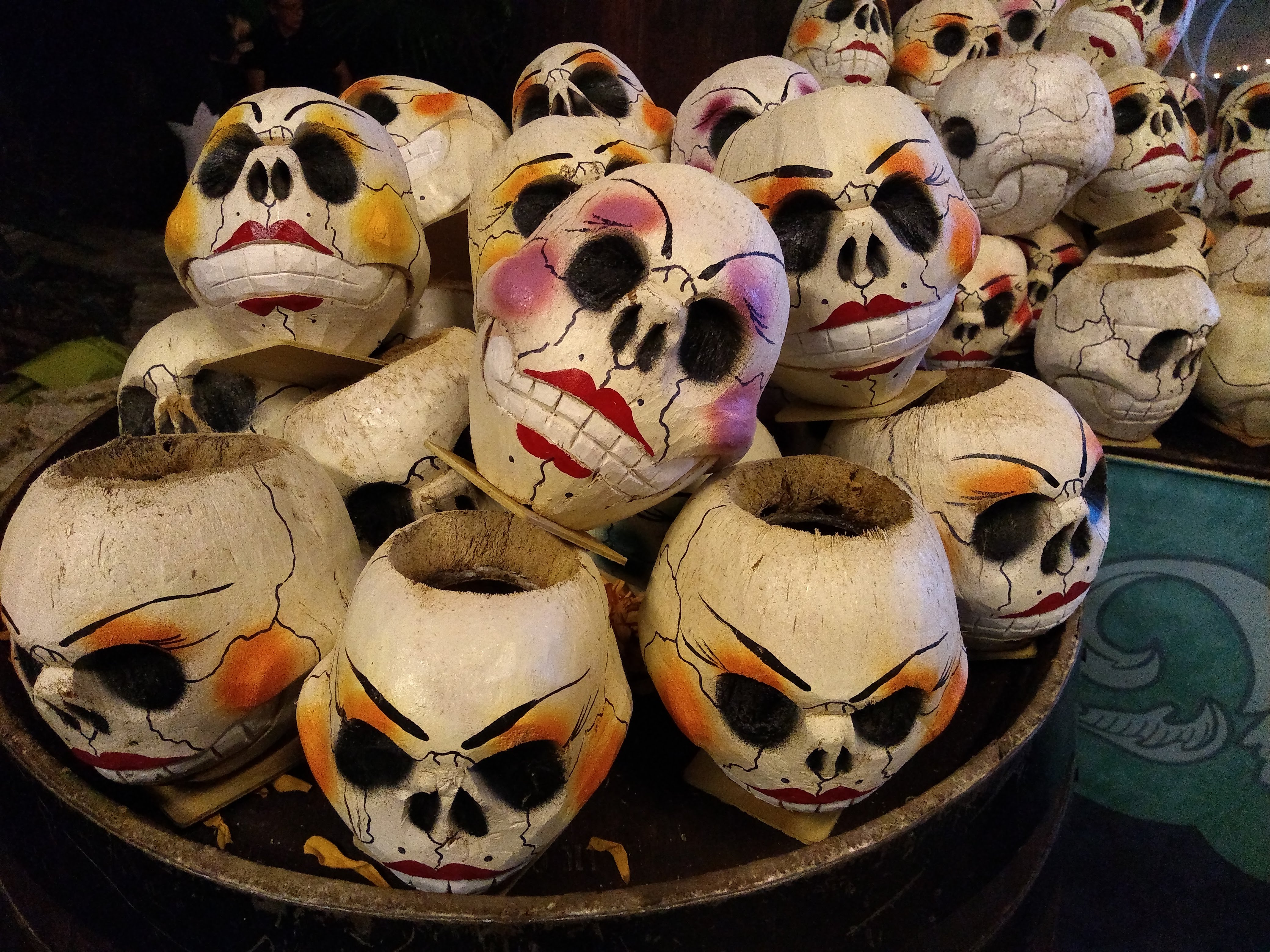
Dia de Muertos, or Day of the Dead in Mexico is not the typical halloween tradition that we all come to know in western society. Halloween is usually celebrated across the world with scary stories, wicked costumes and children running from door to door to collect candy. Therefore when we see the painted skeletal faces associated with Mexico’s Dia de Muertos, this conjures up scary imagery and we couldn’t possibly imagine why people would want to paint this on their faces. What I have learnt in my first Dia de Muertos is that this tradition is far from scary, and in fact it is a profound, heartwarming way of honouring the memory of loved ones.
The meaning of Dia de Muertos
The Aztecs and Mesoamericans had a month worth of traditional customs to honour their dead, but when the Spanish arrived in Latin America, their Catholic influences soon became mixed into what it is known as today. The festivities for Dia de Muertos begin the day after Halloween, on All Saints Day, November 1. It is dedicated to remembering all the saints and martyrs throughout Christian history. It falls close to the Celtic holiday of Samhain, which has a theme similar to the Roman festival of Lemuria. Legend goes that the souls of children return to the world of the living on November 1, followed by the adult spirits on the Day of the Dead, the 2nd of November (or All Souls Day). During this mystical time of year, it is said that a portal opens where the spirits of the dead can pass through into the world of the living. On both of these days, families visit the graves of their loved ones who have passed on, clean it up, decorate them and give offerings to invite their spirits to visit them whilst the portal is open for these two days.
Although there are only two recognised days, locals gear up for the custom during all of October, and in some parts of Mexico, festivities begin at the end of October, through Halloween and others continue for much of November. Customs vary across the country, with each state having their own unique festivities. So far, I have noted the huge parade in Mexico city’s Zocalo Square, an all-night candlelit vigil in the famous cemetery in Patzcuaro in the state of Michoacan, and a yearly spectacular display at Xcaret theme park in the Riviera Maya, which is where I went this year.
La Catrina: The Elegant Skull
One of the biggest traditions of Dia de Muertos is the appearance of the painted skull, which is known as La Catrina, or the Elegant Skull/Skeleton. This image arose from the artistic work of illustrator José Guadalupe Posada, and has become the referential image of death in Mexico. During Dia de Muertos, men, women and children can be seen painting their faces with skeletal features, and people offer professional makeup as a service at this time of year. Whilst the skeleton may seem scary to those outside of the Mexican culture, the fashioned details such as flowers, rhinestones and love hearts featured in the makeup are anything but. Some people do a full face catrina, and others a half face, signifying both life and death. I decided to create my own makeup this year, exciting myself looking at designs and wandering around town buying the makeup necessary. Xcaret provided makeup stations for visitors, however they were so full of people I was glad I had my own makeup and went straight to the air-conditioned bathroom so it didn’t drip off my face in the humidity!)
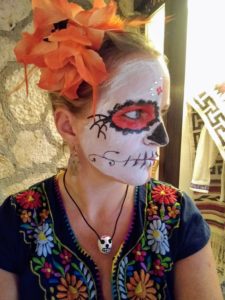
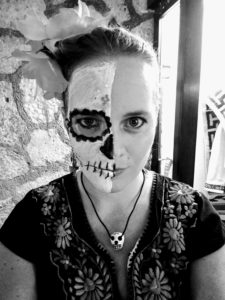
Alters and other Day of the Dead Traditions
Alters make up one of the biggest traditions of Dia de Muertos, where families create an homage to their dead relatives in order to call them back home as their spirits wander through the portal. Businesses and homes all round can be seen with alters, from small and simple to large and glorious. On an altar you will see:
Candles
A common feature on any cultural or religious alter, helping to light the path for the spirits back home.
The marigold flower
Known in Mexico as Cempasúchitl, marigolds guide the spirits to their altars using their strong scent and their vibrant colors, with the brilliant orange representing the sun. The flowers are harvested throughout the month of October and are placed on alters, on headdresses and petals are strewn on the grounds in front of the alters to help spirits find their way.
Photos of loved ones passed on
This is very important so that the spirit knows he has not been forgotten by his family. Anyone who has seen the Disney movie Coco will understand this (and if you haven’t you should. Mexicans here believe it was a good adaptation of their culture).
Food and candy
Families place food, sweets and goodies that their ancestors used to love, assisting further with them finding their way home. Small colourful candy skulls are a popular item on alters as well.
Copal
Copal is a smoky incense that was burnt in Mesoamerican times and can be seen burning year-round in churches in Mexico. Its smoke is said to aid with signalling the spirits’ path to the living world.
Pan de muertos
No Day of the Dead festivity is complete without this iconic sweet pastry. The origins were quite bloody, forming a replacement by the Spanish conquerers to the Aztec heart sacrifices during their Day of the Dead customs. The four ridges along the top represent the skeleton, the knot on the top in the centre representing the cranium (which, I have heard, is the part that everyone wants first). Made in both large-scale bakeries and artisanal bread-shops, there are various flavours, with the most popular being aniseed and orange blossom, covered in sugar and de-li-cious!
Here is a selection of photos from the festivities. Click on each image to enlarge, and you will find more photos on my Facebook.
Xcaret showcases Zacatecas for Dia de Muertos 2018
Theme park Xcaret in Mexico’s Riviera Maya by day is known for its adventurous tours, rivers, animals and cultural displays. However each year during Dia de Muertos, the park comes alive at night to celebrate the Day of the Dead customs from all over the country. Each year, the park invites one state to come and showcases their Dia de Muertos customs, including food, clothing, music and dance. People arrive from 4pm from 30th October to 2nd November and walk around the park to see a variety of shows from the chosen state – this year it was Zacatecas, a state I knew very little about and was glad to hear their happy music and joyful dancing, proving that Dia de Muertos is as much as celebration of life as well as a grieving of the dead.
Note: If you cannot see the videos, please check out my Facebook page where I will upload them.
A Happy Celebration
There’s no denying that the death of a loved one is sad, however the commercialised Halloween customs have also made death scary. This is where I think Mexico shines. They believe that also the passing of a loved one is to be mourned, there is something to be celebrated in the life that they did lead, and the love they shared. Most importantly, the strong sense of family here teaches us never to forget our ancestors, and, every now and then, light a candle in their honour.

